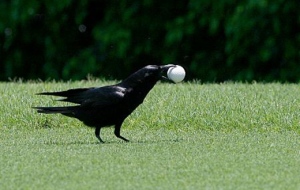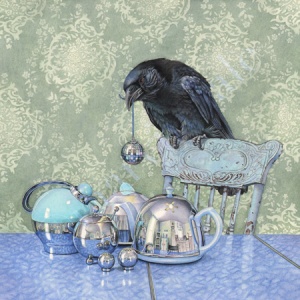The notion that corvids, especially magpies, have a special affinity for shiny object has been around for more than a century. In fact to refer to someone as a magpie is to describe them as someone who ‘compulsively collects or hoards small objects’. This idea is so old hat that it can feel a bit frivolous to even wonder if it’s true. The trouble with this bit of corvid whimsy, however, is that when we do investigate it, and scientists have, we find there’s no empirical evidence to support it.
For instance, one study presented both captive and free-living magpies piles of blue or shiny silver screws, rings, and pieces of tin foil near piles of food to which they had been previously habituated.1 They found that, rather than thieving and subsequently caching the gleaming objects, the birds were actually more nervous to take food than they had been previously. In the 64 conducted tests, only two instances of contact between a bird and an object were recorded.

Experimental set-up for magpie study.
Cornell crow expert Kevin McGowen, elaborates on this general conclusion, suggesting that perhaps the origin of this folklore is pet crows who are attracted to the objects of obvious value to their owner like coins, keys or jewelry. Speaking personally as someone who has spent countless hours observing hundreds of individual crows in the field, I can also attest to the fact I have never witnessed anything resembling this behavior. So there you have it, corvids do not, according to the best empirical evidence, show an attraction to, or are otherwise known to collect shiny objects.
And yet…
And yet I still hear anecdotes about this behavior that peak my curiosity. For instance, once or twice a year I’ll see a headline about crows thieving shiny stones at the expense of bereft family members. In Jewish culture, it’s tradition to leave a small stone atop a gravestone, as a way to honor the deceased and indicate that they’ve been visited. For whatever reason, particularly across Ireland, these stones occasionally go for joy rides in the mouths of crows. In Omagh, Patsy Kerlin who mounts headstones in his town’s graveyard recently told a local reporter that “It seems to be only the black shiny ones they take and a lot of them go missing.” Even in my own neck of the woods at the University of Washington one of the gardeners at the Urban Horticulture Center regaled John Marzluff and I with his story of how the crows regularly steal the shiny metal placards that identify the center’s plants.
In science, we often like to say “the plural of anecdote is not data”. This is unequivocally true. But just because they’re not data doesn’t mean they’re meaningless either. I’m inclined to believe there’s more to these stories than random chance and I think they are worth exploring. Perhaps these stories emerge out of confirmation bias, meaning people tend to report theft with respect to shiny things more often because they’re looking to confirm a suspicion they already had. If so, it would be yet another fascinating example of the extent to which corvids have infiltrated our culture. Or perhaps this is the work of curious juveniles as has been suggested by my crow colleague Dr. Jennifer Cambell-Smith. If so, teasing out any evidence of discrimination or bias juveniles are using when selecting objects to explore could give us insight into how they learn about the world, or how our garbage is modifying that behavior. Or perhaps crows do like to carry off with glossy objects, but for textural, rather than visual reasons. At least some corvid species swallow small stones to aid in digestion and these stones are most often partially smoothed.2 These ‘grit stones’, however, are considerably smaller (on average only 2.9 mm) than I imagine grave stones are, so perhaps this behavior is evidence of poor grit stone selection among naive birds.

Photo: National Club Golfer
Or maybe it’s none of the above, we simply cannot say. Which, for me, is exactly why I find these anecdotes so interesting. While we can rule out that this behavior isn’t a manifestation of corvids’ love for bling, we can’t exactly explain this behavior either. It’s yet another item on the shelf along with thieving golf balls and wiper blades where we can’t do much more than offer an educated guess. So while I’m quick to clarify that crows are not attracted to shiny objects, I’m not dismissive of these anecdotes either. My friend and colleague David Craig likes to say that every bird has a story, and citizen science is part of sharing that story. In my book, the story of corvids and their light fingered behavior seems an ideal project for the crow minded bird nerd.
- Shepard, T. V, Lea, S. E. G., and Hempel de Ibarra, N. 2014. Thieving magpie’? No evidence for attraction to shiny objects. Animal Cognition 18: 393-397.
- Gionfriddo, J.P., and Best, L. B. 1996. Grit-use patterns in North American birds: The influence of diet, body size and gender. The Wilson Bulletin 108: 685-696

